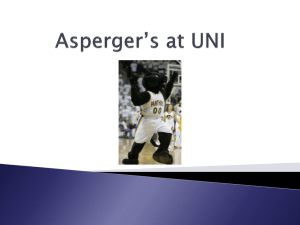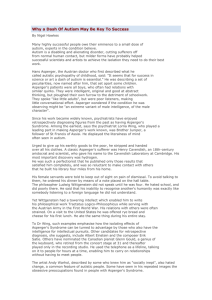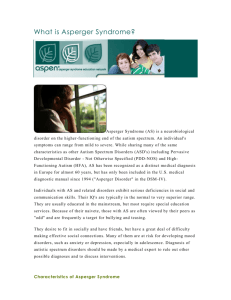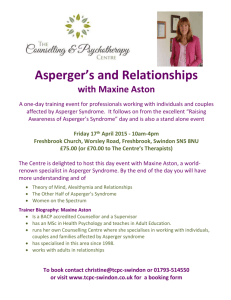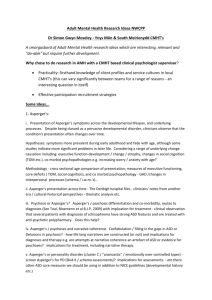Asperger's Syndrome or What a Weird Kid!
advertisement
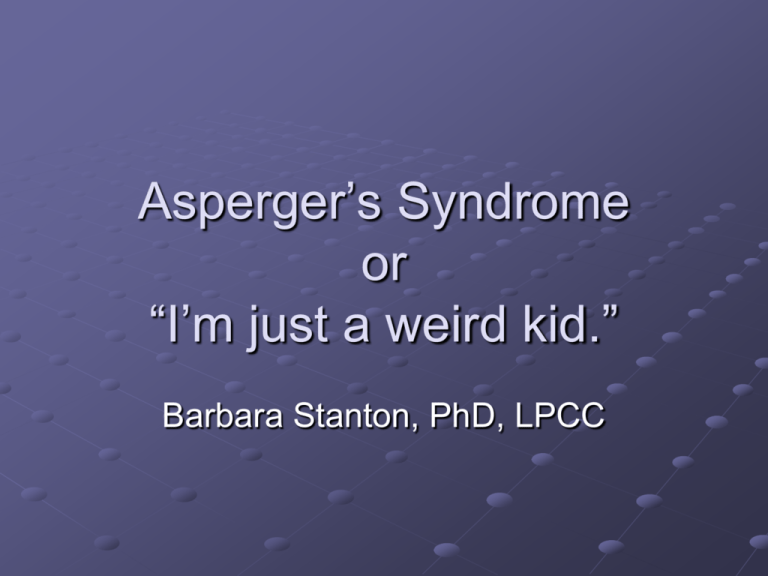
Asperger’s Syndrome or “I’m just a weird kid.” Barbara Stanton, PhD, LPCC “We are convinced, then, that autistic people have their place in the organism of the social community. They fulfill their role well, perhaps better than anyone else could, and we are talking of people who as children had the greatest difficulties and caused untold worries to their care-givers.” Dr. Hans Asperger (1944) Autism vs. Asperger’s Many similarities Social difficulties Communication differences Theory of mind Aspies are very verbal Average to superior IQ Asperger’s, High Functioning Autism, PDD-NOS, Non-verbal Learning Disability “These children often show a surprising sensitivity to the personality of the teacher. However difficult they are even under optimal conditions, they can be guided and taught, but only by those who give them true understanding and genuine affection, people who show kindness towards them, and, yes, humor.” Hans Asperger, 1944 History and Statistics Dr. Leo Kanner: 1943 Dr. Hans Asperger: 1944 Dr. Lorna Wing: 1981 Dr. Tony Attwood: 1980s Asperger’s added to DSM in 1994 No quantitative studies to date, most is qualitative/anecdotal information Over last ten years individuals identified with Autism Spectrum Disorders have gone from 1 in 5000 to 1 in 88 (2012) 4:1 males to females Often misdiagnosed Under diagnosed in females The difference between boys and girls Diagnostic Criteria DSM IV TR: Impairments in communication Social interactions Repetitive/stereotypic behaviors DSM V Potential changes may restrict the upper end of the spectrum. We will wait and see…. Co-morbid Conditions or Misdiagnoses Obsessive Compulsive Disorder Anxiety Disorders Mood Disorders Bipolar Disorder Conduct Disorders/ODD Depression ADD/ADHD Schizophrenia (may be characteristic of ASD) Brain Differences Neurological Cellular differences in the limbic system and the cerebellum (emotions/thought) Differences in the amygdala (emotions/impulsivity) Functioning of the frontal lobe impaired (executive functioning) Chemical pathways Differences in myelin Mirror neurons It is neurobiological…it is not their fault, they cannot help it and it will last a lifetime. Causes Nobody knows Theories include: Genetics (inherited) Unfavorable obstetric condition Infections in pregnancy and infancy Early immunizations Foods may produce a toxic reaction that kills brain cells opening a path to ASD (gluten) Environmental toxins Why professionals may miss the identification Lack of knowledge Trouble differentiating characteristics (i.e parallel play vs. interactive) Gender differences Want child to be typical Preconceived ideas (not like other ASD children) Parents have been training Don’t ask the right questions Influence of medication on behavior/thought Influence of RTC or other placements Assessment General assessment by someone familiar with autism spectrum disorders Neuropsychological assessment Occupational Therapy assessment Speech/language assessment (primarily for social language) Challenges They may appear: To not pay attention To not follow the rules To not understand you To not care what’s happening around them To be clueless To over react To be rude, manipulative, aggressive They are: Autistic Be calm, unemotional, thoughtful, and respectful. CHARACTERISTICS OF ASPERGER’S SYNDROME Spectrum within the Spectrum The characteristics will vary in degree within each individual with Asperger’s Syndrome. For example, some are more gifted in the arts while some have their gifts in technology. Some will have aggressive meltdowns while others will withdraw passively. Some will be very physically uncoordinated while some will be skilled athletes. Who should change? Asperger’s may be a form of human genius that will save the world (Attwood, Baron-Cohen). The pleasures vs. the pain of Asperger’s. Honor neurodiversity. The Controversy Should there be a cure? Dr. Simon Baron-Cohen (Cambridge University) invites us to question what is “normal”. He sees Asperger’s not as an impairment but as a natural variant of humans. Without people with AS we would not have the same world or the same chance for change. The illusion of competency The Key: Executive Skills Working memory and recall (hold facts in memory while manipulating information, accessing facts in long term memory, trouble following instructions, trouble summarizing, can impact sense of past events, sense of time, sense of self awareness, sense of the future) Activation, arousal, and effort (getting started on a task, paying attention to things of varying interest, finishing work, sustained attention) Internalizing language (direct future actions, control behavior by self talk) Taking an issue apart, analyzing the pieces, reconstructing and organizing and sequencing events Time management Controlling emotions (emotional dysregulation, frustration tolerance, thinking before acting or speaking) Mental Flexibility: Shifting sets (moving one thought to another) or make transitions to other places or activities; rigid or stuck thinking Metacognition: Seeing the big picture from smaller parts Adaptive behavior: ability to change from one behavior to another to achieve success in the situation Theory of Mind The ability to recognize and understand beliefs, thoughts, desires and intentions of other people is impaired. They are unable to predict what people will do next as they are unable to “read” the cues. Cannot “put themselves in someone else’s shoes”. LANGUAGE Stiff, pedantic conversation (“little professors”) may sound scripted/superficial Intonation and inflection seems odd Preoccupation with a special interest that they will talk about endlessly Problems with social use of language (literal interpretations), no reciprocity Inability to interpret and express nonverbal language (facial expressions) Difficulty understanding rules for social engagement, games. Misconstrues other’s agenda’s, priorities, and preferences. The “hidden” curriculum (Brenda Smith-Myles) May interrupt, dominate, minimally participate, have trouble shifting topics, problems initiating and termination conversation. Insensitive to non-verbal cues of others. Apparent lack of common sense. Joint attention limited. Can’t self advocate. Can’t explain what’s wrong or what they are feeling. “Smart ass” responses, blunt “Revealers of the truth” (Attwood) http://www.youtube.com/wa tch?v=ibCck2iDOqA DMV EMOTIONAL ISSUES Lack of shared enjoyment (mind-blindness) May seem apathetic or not empathetic, they can’t see things from another’s perspective. Social cognition Negativistic world view Difficulty with peer relationships Good connection with adults Emotional lability and anxiety Low tolerance for frustration, refusals Anxious, anxious, anxious, depression Transitions difficult They understand from their world view. May have tantrums/rages or withdraw Can’t distinguish other people’s emotions May seem aloof and indifferent Are naïve or gullible Good sense of humor Social and emotional maturity delays Extremes in emotions Take all or no responsibility Attribution Theory When we do something well we will believe that it is because of something we did (worked hard…) but an AS child will think they got lucky if they did something well. If they do poorly, they will blame the teacher (she doesn’t like me) or their parent (unfair). Therefore they put in no effort because they have no control over the outcome. EXECUTIVE FUNCTIONING High intelligence, articulate Rigid, concrete thinking Unique world view…rules must fit Things must be fair Organizational problems Abilities to learn certain subjects Talents with arts or foreign language Poor short term memory, excellent long term memory Can’t generalize situations Difficulty with comprehension Dysgraphia (handwriting difficult) Difficulties with transitions Strong sense of what is fair Different academic profile (excel in some subjects, fail in others) Homework is misery. Processing takes longer Thinking all the time…they can’t stop. Can’t make choices. Difficulty with new tasks (perfection or anxiety). May be able to listen and remember better when involved in another activity. Usually multi-tasking is difficult. A neuropsychological assessment will be useful to identify their needs and learning style. BEHAVIOR Behavior is communication. Learn to translate. BEHAVIORAL ISSUES Sensory integration problems (touch, sound, taste, sight) If affected they will freak out and may be fascinated by it Stimulation…flapping, hopping, fidgeting, sucking, chewing, rocking, twirling Motor clumsiness, fall, difficulty with balance, unusual gait (toe walkers) Inappropriate or no eye contact (functional eye contact) Don’t know the message they are sending or receiving, nonfunctional. No understanding of danger/risky behaviors Appears to be obsessive compulsive: perseveration (unable to shift sets) Non-compliant and oppositional Tantrums and rages, explosive, quick meltdowns (sometimes over nonfunctional details of their environment) or withdrawal High pain tolerance Can’t mimic No sense of personal space Adolescence X10 (seizures with puberty) May have bad or unusual hygiene. Rigidly adhered routines. Collecting “treasures” Typical rewards and consequences do not work. There is a reason for EVERY behavior. It may take us a while to figure it out. Every person is different. Adaptive Behavior Typically, IQ will correlate to adaptive behavior. For example, someone with an IQ of 65 would have adaptive skills at 65. Children with AS do not meet that profile. If they have an above average IQ (110) they will have an adaptive skills score of 65. Therefore we have to teach adaptive behaviors. 20% of AS children have an above average IQ but their social maturity is 1/3 to 2/3 of chronological age. http://www.youtube.com/watch?v=p49epME JE0E&feature=related sensory overload Sensory Issues Sensory problems impact: Reading Writing Math Spelling Problem solving Creativity Behavior Mastery of environment Independent skills Independent work habits Socialization Creativity Relationships Emotions Behavior Mastery of environment Sensory Issues Sound (auditory) Taste (gustatory) Smell (olfactory) Touch (tactile) Movement (vestibular) Sight (visual) Muscle input/joints (proprioceptive) Sensory seeking/sensory avoiding Incorporate sensory activities into the full day not just a pull out activity Do NOT use holds unless absolutely necessary. If a child can’t read, we teach If a child can’t tie their shoes, we teach If a child can’t ride a bike, we teach If a child can’t behave appropriately, we punish… The Hidden Curriculum These are the social rules that no one has been directly taught but everyone knows them. Violations of these rules can make you a social outcast or can even be illegal. If you are saying “I shouldn’t have to tell you”, “It’s so obvious” or “Everybody knows…” it is a hidden curriculum. Brenda Smith Myles Bullies Children with AS are vulnerable. They may not always see the threat. Little (2002) surveyed 400 parents of children with ASD and found that 94% of the children had been bullied. When compared to the general population they are 4X more likely to be bullied, twice as likely to be hit or kicked by peers. We must have ZERO tolerance of bullying behaviors. We must monitor the situations carefully. Types of Bullying Physical bullying Verbal bullying: teasing, language, gestures, non-verbal communication Social bullying: isolation, manipulation Educational (Systems) bullying: when adults who are charged with assisting children use sarcasm, control, humiliation, or are overly punitive 90% report being bullied 1X per week. 75% report it gets worse when the teacher is told. Heinrichs (2003) Perfect Targets “You tell me, and I forget; you teach me, and I remember; you involve me, and I learn.” Ben Franklin Learn the Nurtured Heart Parenting Approach By Howard Glasser Offending Behaviors Appearance of a lack of empathy (Theory of Mind) Lack of awareness of social rules; socially naive Can’t understand potential outcome of behavior Impulsivity Desire to connect with others can lead to misinterpretation of relationships Difficulty judging age/maturity of others Obsessions/compulsions Stuck behaviors Central coherence: excessive preoccupation without understanding consequences…maladaptive fantasies Look for general cluelessness to behaviors and consequences Over-represented in sex offender programs Knowing is different than implementation. ASD child and abuse May display behaviors/symptoms similar to neurotypical children or may not Lack of emotion attached to event Doesn’t understand inappropriateness of behaviors Exposure to pornography can shape future behaviors Obsessive thoughts Interviewing Techniques Interviewing will be difficult due to the language and information processing problems. Learning how to talk with people on the spectrum will strengthen your case. Inappropriate interviewing may damage your understanding. Remember the “illusion of competency”. Do not use open-ended questions. Speak using concrete simple sentences. Do not put together multiple ideas. Do not use words with double meanings or idioms. Do not expect or force them to make eye contact. Use visual aids. Let them do a calming activity while interviewing. Do not interfere with stimming behavior. They may answer in a way they think you expect them to. They want to please. Do not be sarcastic or threatening. Do not make promises you cannot keep. Do not attempt to confuse or trick them. If you ask, “Do you understand” they will likely say “yes” even when they don’t. They may not know that they don’t understand. Check it out by using different language. (Watch for echolalia or scripting.) They will not tell you they don’t understand. Give them enough time to process the question. Their first response may me “I don’t know” or “I don’t care”. This will be a way to get time. They may answer just to get you to go away. Empathize and show respect to them in order to get respect back. Include a parent or trusted adult in questioning. Especially someone who speaks “aspie”. Do not look for “typical” emotions. Use their special interest. Give them a chance to de-escalate on their own…distractions are not rewarding bad behavior. Repeat or re-phrase questions. Appeal to the intellect and logic. Watch for sensory concerns. Model calm behavior, breath slowly and keep your distance Interventions… Evidence Based The known… social stories, video modeling occupational/speech therapy coaching/therapy assistive technology Maybe… diet medications patterning (neurological exercises) Scary and dangerous… Neurofeedback Son-Rise (emphasis on eye contact) Packing (wrap child tightly for hour in refrigerated wet sheets) Cannabis (THC counteracts inhibitory mechanisms) Chelation therapy (detox from heavy metals) Cranioacral therapy (gentle pressure will improve flow and balance of cerebrospinal fluid) Hyperbaric oxygen therapy (compensates for decreased blood flow by increasing oxygen) Stem cell therapy (only in proposal stages) The vaccination issue… General Approaches Approach in a quiet non-threatening manner. Avoid sudden movements or speech. An authoritative approach is likely to work against you. Talking/shouting fast/loud will have the same effect as speaking a foreign language. Understand that touch, sound, lights may trigger a meltdown/seizure. Try not to touch them. Let them know what you want them to do and what you are doing. Talk to the person using calm unemotional responses. Avoid engaging in arguments: (Instead say…I know this doesn’t make sense to you but I need to have you…). Be patient for responses. You may need to ask several times. Explain the obvious. Your authority is not enough. Instructions should be simple, direct and honest. Don’t use sarcasm, innuendo, or slang. Use literal language (i.e. don’t say hop in here, red tape, up against the car…). Tell them only one command at a time. Seek all indicators to evaluate the situation as it unfolds. Evaluate for injury…they have a high tolerance for pain. Maintain a safe distance until behaviors lessen but remain alert to the possibility of outbursts or impulsive acts. Do not corner the individual or place them in an enclosed space unless they request it. Do not stop stimming behavior. . Ask yourself, “Is this oppositional behavior or the behavior of someone with autism?” What do you need to understand? It doesn’t negate the maladaptive activity but may be important in the intervention. Research indicates that children with Asperger’s Syndrome should not be in programs that include children with behavioral or emotional problems. Make Plan A; Plan B and an escape plan. http://www.youtube.com/watch?v=k0xgjUhE G3U friendship Historical People who Displayed ASD Characteristics Thomas Jefferson Albert Einstein Charles Darwin Isaac Newton Hans Christian Andersen Wolfgang Mozart George Orwell Charles Richter Emily Dickenson Vincent Van Gogh Andy Warhol Karl Jung Wasily Kandinsky Henry Ford Carl Jung Mark Twain Alexander Graham Bell Franz Kafka Famous People Identified with ASD Characteristics Dan Ackroyd (actor) Darrell Hannah (actor) Gary Numan (singer/composer) Vernon Smith (Nobel Prize Economist) Satoshi Tajiri (creator of Pokemon) Bob Dylan (singer-songwriter) Al Gore (politician, activist) Crispin Glover (actor) Bill Gates (businessman) Garrison Keillor (writer, humorist) Woody Allen (actor, writer, director) Michael Palin (comedian) Keenu Reeves (actor) Fictional Characters with ASD Characteristics Calvin (of Calvin and Hobbes) Dilbert Napoleon Dynamite Sheldon in The Big Bang Theory Many Gary Larson characters Mr. Spock (Star Trek) Cliff Clavin (Cheers) Chance the Gardener (Being There) Sherlock Holmes Brick (The Middle) Look through the Asperger’s Lens Red River Valley Asperger Network For more information: www.rrvan.org Interesting Books…. • The Complete Guide to Asperger’s Syndrome (2007) Tony Atwood Or if you buy more… • Look Me In the Eye: My Life with Aspergers (2007) John Robison • Born on a Blue Day: Inside the Extraordinary Mind of an Autistic Savant (2006) James Tammet • Anything by Temple Grandin More Books…. The Explosive Child and Lost at School Ross Greene Executive Skills in Children and Adolescents: A Practical Guide to Assessment and Intervention (2010) Peg Dawson EdD, Richard Guare Phd The Nurtured Heart Parenting Approach Howard Glasser Anything by Temple Grandin Acknowledgments OASIS (Kirby and Bashe) Dr. Tony Attwood Dr. Brenda Smith Myles Dr. Cathy Pratt Kirby Lenz Kari Dunn Buron Dr. Simon Baron Cohen Dr. Ami Klin The “experts”, those with Asperger’s Syndrome and their families Dennis Debbaudt (law enforcement issues)

